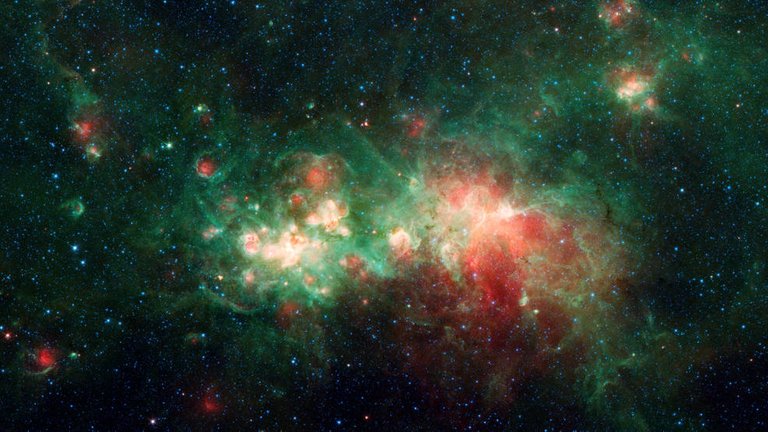How and Where stars are created?

Image credit: NASA/ JPL-Caltech (Source : NASA)
The largest stars within the universe are brought into the planet within cosmic clouds of gas and dust, wherever they leave hints regarding their lives for astronomers to interpret.
The nebula called W51 is one among the foremost dynamic star-forming districts within the Milky Way galaxy. First recognized in 1958 by radio telescopes, it makes a rich cosmic tapestry in this picture from NASA's as of late retired Spitzer Space Telescope.
Situated around 17,000 light-years from Earth, toward the constellation Aquila within the night sky, W51 is around 350 light-years – or around two quadrillion miles – over. It's much indiscernible to telescopes that gather noticeable lightweight (the kind natural eyes recognize) because that that lightweight is occluded by heavenly body mud clouds that lie among W51 and Earth. However, longer wavelengths of sunshine, together with radio and infrared, will go unencumbered through the dust. When seen in infrared by Spitzer, W51 may be a colossal sight: Its all out infrared outflow is what may well be compared to 20 million Suns.

Image credit: WikiImages (Source: Pixabay)
If you just might see it together with your naked eye, this thick cloud of gas and dirt would show up regarding as in-depth because of the full-of-the-moon. The Orion Nebula – another notable star-forming region and a most preferred looking objective for amateur area consultants – possesses a couple of similar size territory within the sky. Be that because it might, W51 is loaded farther from Earth than Orion and during this manner a lot larger, and it's around multiple times more brilliant. Whereas Orion contains four famous O-type stars – the foremost large stars within the universe – W51 contains over thirty.
"Star factories" like this one can work for millions of years. The cavernous the red on the right side of W51 is older, clear within the manner within which it's simply been cut out by winds from generations of large stars (those at least ten times the mass of our Sun). The dust and gas within the region are sweptback around rather more once those stars die and explode as supernovas. On the nebula's younger left side, various stars are simply commencing to finish off the gas and dust equally the celebrities within a lot of older regions have done. Clarity clear that a significant number of these young stars are currently framing bubbles of void space around themselves.
This image was taken as a feature of a big perception crusade by Spitzer in 2004 to set up the big scope structure of the Milky Way system – a powerful take a look at since Earth lies within it. Referred to as the Galactic Legacy Infrared Mid-Plane Survey Extraordinaire (GLIMPSE), the review likewise turned up necessary info on varied miracles within the Milky Way, as well as footage of various stellar factories like W51 that were hidden by dirt from noticeable lightweight observatories.
NASA's Spitzer Space Telescope dispatched 17 years back this week, on Aug. 25, 2003. The aircraft was resigned in January 30, 2020. Despite the very fact that the mission has finished up, the entire assortment of logical data gathered by Spitzer throughout its lifespan is accessible to the open through the Spitzer information chronicle, housed at the Infrared Science Archive at IPAC at Caltech in the Pasadena , California.
NASA's Jet Propulsion Laboratory, a division of Caltech, oversaw Spitzer mission tasks for NASA's Science Mission Directorate in Washington. Science tasks were led at the Spitzer Science Center at IPAC at Caltech. Spacecraft operations were primarily based at Lockheed Martin's house in Littleton, Colorado.
Reference:
- https://www.nasa.gov/feature/jpl/where-are-stars-made-nasas-spitzer-spies-a-hot-spot
- https://kids.frontiersin.org/article/10.3389/frym.2019.00092#:~:text=Stars%20form%20from%20an%20accumulation,and%20shines%20like%20the%20Sun
- https://science.nasa.gov/astrophysics/focus-areas/how-do-stars-form-and-evolve
- https://www.scientificamerican.com/article/how-is-a-star-born/
- https://science.howstuffworks.com/how-are-stars-formed.htm
Wow! That's a very interesting article to read. Keep it up writing such good articles. Soon you will start flying with the increasing number of followers. 😊✌️